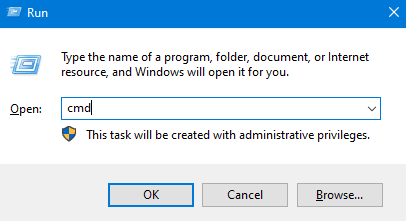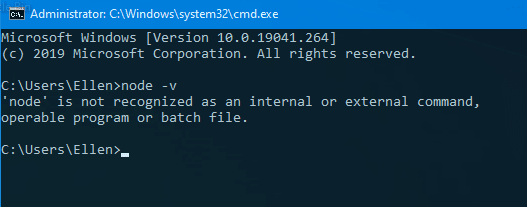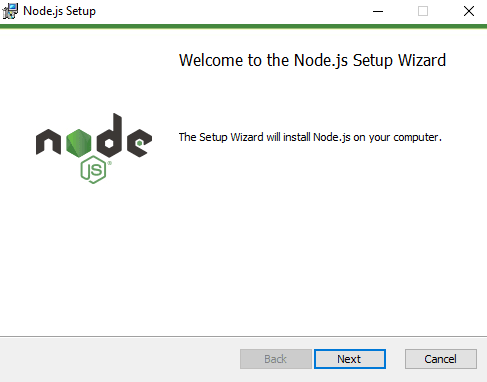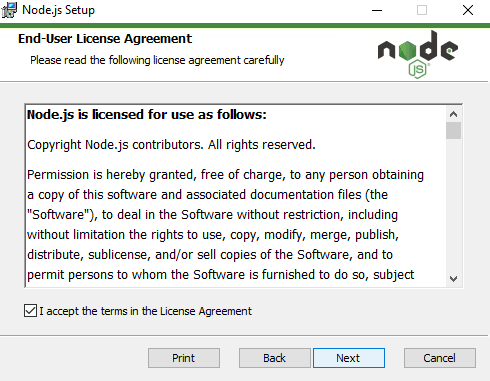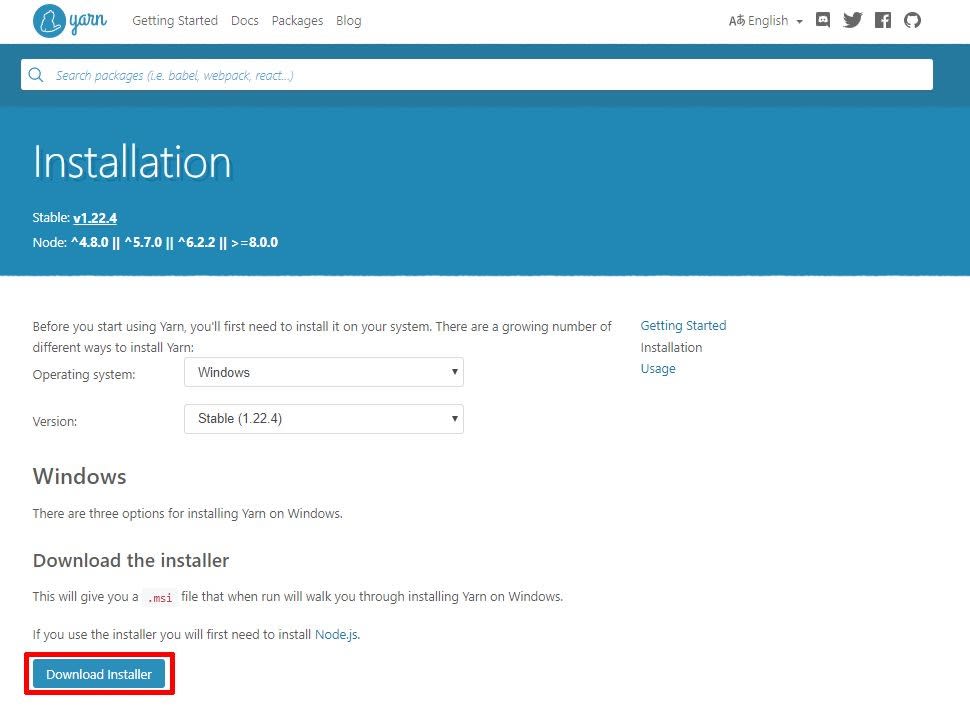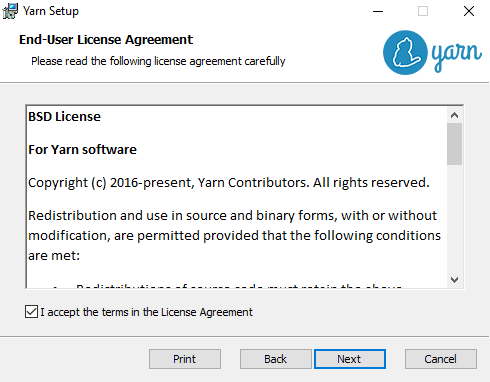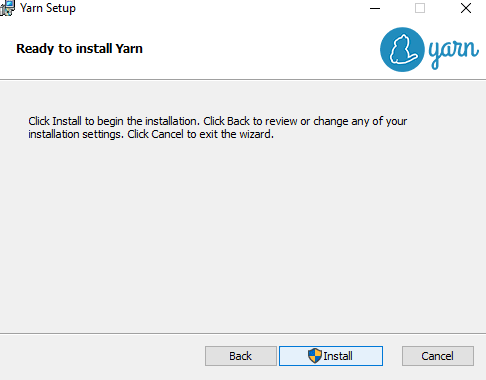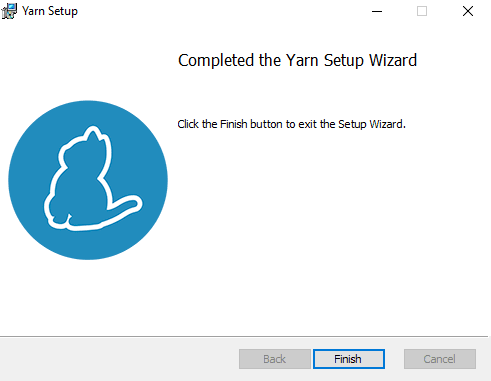- Yarn installation
- How to Install Yarn on Windows
- What is Yarn?
- Prerequisites
- Yarn Installation
- MSI Installation
- Chocolatey Installation
- Scoop Installation
- Installation
- Install via npm
- Alternatives
- Alpine
- Installation Script
- Manual Install via tarball
- Path Setup
- Arch Linux
- Installation Script
- Manual Install via tarball
- Path Setup
- CentOS / Fedora / RHEL
- Installation Script
- Manual Install via tarball
- Path Setup
- Debian / Ubuntu
- Path Setup
- Gentoo Linux
- Installation Script
Yarn installation
In the previous tutorial we told you that you have to install yarn to be able to use it, this tutorial will show you different ways of installing yarn for different operating systems.
Installing yarn on Alpine, Arch and Gentoo Linux
To install yarn on Alpine Linux (3.6+) you can use the following commands:
To install Yarn on Arch Linux you can use:
To install Yarn on Gentoo Linux you can use portage:
Both the RC and nightly builds of Yarn do not have packages for Alpine, Arch and Gentoo.
Installation Scripts
Yarn will be installed when you run the following commands in your terminal:
During the installation, a GPG signature will have to be verified.
If you want to use a particular version, you can also specify that using:
Manual install via tarball
It is possible to install Yarn by downloading and extracting a tarball following any of the steps below:
Before you extract Yarn, we recommend that you verify the tarball using GPG:
Path Setup
If Yarn is not in PATH, you can follow these steps to add it and enable it to run anywhere.
It should be noted that your profile can be found in your .profile, .bash_profile, .bashrc, .zshrc, etc.
- You have to add this to your profile, using export PATH=»$PATH:/opt/yarn-[version]/bin» (the path varies depending on where you extracted Yarn to)
- Log in and log out in the terminal, for the changes to take effect
If you want to access Yarn’s executable globally, you need to set up the PATH environment variable in your terminal by adding export PATH=»$PATH:`yarn global bin`» to your profile, or you if you are familiar with fish, you set PATH $PATH (yarn global bin) in the
Installing Yarn on CentOS/ Fedora /RHEL
You can install Yarn on CentOS, Fedora and RHEL using the RPM package repository provided by Yarn.
You should configure the NodeSource repository, if you don’t have Node.js is not installed.
Then you can run any of these commands:
Installation Script
Yarn will be installed when you run the following commands in your terminal:
During the installation, a GPG signature will have to be verified.
If you want to use a particular version, you can also specify that using:
Manual install via tarball
It is possible to install Yarn by downloading and extracting a tarball following any of the steps below:
Before you extract Yarn, we recommend that you verify the tarball using GPG:
Path Setup
If Yarn is not in PATH, you can follow these steps to add it and enable it to run anywhere.
It should be noted that your profile can be found in your .profile, .bash_profile, .bashrc, .zshrc, etc.
- You have to add this to your profile, using export PATH=»$PATH:/opt/yarn-[version]/bin» (the path varies depending on where you extracted Yarn to)
- Log in and log out in the terminal, for the changes to take effect
If you want to access Yarn’s executable globally, you need to set up the PATH environment variable in your terminal by adding export PATH=»$PATH:`yarn global bin`» to your profile, or you if you are familiar with fish, you set PATH $PATH (yarn global bin) in the
Installing Yarn on Debian/Ubuntu
You can install Yarn on Debian or Ubuntu, using the Debian package repository provided by Yarn. However, you have to configure the repository first:
How to Install Yarn on Windows
What is Yarn?
Yarn is an alternative npm-client used for working with JavaScript as a package manager that was developed by the Facebook team. It also allows us to share code with other developers around the world and use solutions from other developers. The code itself is distributed via packages, sometimes referred to as modules. The package contains a .package.json file which describes the contents, as well as all the associated distributed code. In comparison with npm, Yarn is considered to be a better alternative and surpasses NPM in the following parameters:
- Speed compared to the standard client, while there are comparisons and testing where Yarn was two to three times faster.В
- Reliability of installation. The reliability is better for two reasons:
- Short-term computer network problems can cause a failure in receiving packets.
- When new versions of packages are released, there may be changes that are incompatible with other packages which could disrupt the application. Yarn addresses these two problems and solves them easily.
- Yarn is also compatible with Npm and Bower.
Prerequisites
Node.js must be installed before installing Yarn. We can verify if node.js is installed on our system using the Windows terminal or powershell.В
1. Open the terminal by pressing the Win+R buttons and then enter cmd.В
2. Using the command line, we can verify if Node.js is installed with the command:
If we do not have node.js installed, we can go to the main node.js website and download the installer.
Next, we need to run the installer.
Now, we should accept the license agreement.
Now, leave all the defaults set and click Next to install node.js.
Finally, click on Finish, to complete the installation. Now we can rerun our command to verify node.js installed correctly using the following command in the terminal:
Yarn Installation
MSI Installation
The first method we will use to install Yarn is to Download the Yarn .msi installer from the official Yarn website and install it on our local computer.В В
Next, we will run the .msi installer.В
Now, accept the license agreement.
Then, click Install.
And finally, click on the Finish button.
Now, we can verify Yarn was installed using the following CLI commands.
Chocolatey Installation
Another way to install Yarn is by using the Chocolatey package manager for Windows. This method is convenient because Chocolatey will determine whether node.js is already installed and if not, it will automatically install it for us. It is important to do everything as an administrator. Here are the instructions for installing Chocolatey.
Once Chocolatey is set up, we can install Yarn using the following command.
Finally, we can verify our installation of yarn using the following command.
Scoop Installation
The third method of installing Yarn is by using the Scoop command line installer for Windows. Scoop has functionality that is similar to Chocolatey, but the main difference being that Chocolatey will install node.js if we do not already have it installed but scoop will not. Scoop can be installed using the information found at the scoop website.В
To install node.js using scoop, run the following command.В
Next, we can install yarn using this command.
Installation
Install via npm
It is recommended to install Yarn through the npm package manager, which comes bundled with Node.js when you install it on your system.
Once you have npm installed you can run the following both to install and upgrade Yarn:
Alternatives
Alpine
On Alpine Linux (3.6+), you can install Yarn with apk.
Currently, there are no Alpine packages available for RC or nightly builds of Yarn. Please use the tarball:
Installation Script
One of the easiest ways to install Yarn on macOS and generic Unix environments is via our shell script. You can install Yarn by running the following code in your terminal:
The installation process includes verifying a GPG signature. View the source on GitHub
You can also specify a version by running the following code in your terminal:
See the releases for possible versions.
Manual Install via tarball
You can install Yarn by downloading a tarball and extracting it anywhere.
Before extracting Yarn, it is recommended that you verify the tarball using GPG:
Path Setup
If Yarn is not found in your PATH, follow these steps to add it and allow it to be run from anywhere.
Note: your profile may be in your .profile , .bash_profile , .bashrc , .zshrc , etc.
- Add this to your profile: export PATH=»$PATH:/opt/yarn-[version]/bin» (the path may vary depending on where you extracted Yarn to)
- In the terminal, log in and log out for the changes to take effect
To have access to Yarn’s executables globally, you will need to set up the PATH environment variable in your terminal. To do this, add export PATH=»$PATH:`yarn global bin`» to your profile, or if you use Fish shell, simply run the command set -U fish_user_paths (yarn global bin) $fish_user_paths
Arch Linux
On Arch Linux, Yarn can be installed through the official package manager.
Currently, there are no Arch packages available for RC or nightly builds of Yarn. Please use the tarball:
Installation Script
One of the easiest ways to install Yarn on macOS and generic Unix environments is via our shell script. You can install Yarn by running the following code in your terminal:
The installation process includes verifying a GPG signature. View the source on GitHub
You can also specify a version by running the following code in your terminal:
See the releases for possible versions.
Manual Install via tarball
You can install Yarn by downloading a tarball and extracting it anywhere.
Before extracting Yarn, it is recommended that you verify the tarball using GPG:
Path Setup
If Yarn is not found in your PATH, follow these steps to add it and allow it to be run from anywhere.
Note: your profile may be in your .profile , .bash_profile , .bashrc , .zshrc , etc.
- Add this to your profile: export PATH=»$PATH:/opt/yarn-[version]/bin» (the path may vary depending on where you extracted Yarn to)
- In the terminal, log in and log out for the changes to take effect
To have access to Yarn’s executables globally, you will need to set up the PATH environment variable in your terminal. To do this, add export PATH=»$PATH:`yarn global bin`» to your profile, or if you use Fish shell, simply run the command set -U fish_user_paths (yarn global bin) $fish_user_paths
CentOS / Fedora / RHEL
On CentOS, Fedora and RHEL, you can install Yarn via our RPM package repository.
If you do not already have Node.js installed, you should also configure the NodeSource repository:
Then you can simply:
Currently, there are no RPM packages available for RC or nightly builds of Yarn. Please use the tarball:
Installation Script
One of the easiest ways to install Yarn on macOS and generic Unix environments is via our shell script. You can install Yarn by running the following code in your terminal:
The installation process includes verifying a GPG signature. View the source on GitHub
You can also specify a version by running the following code in your terminal:
See the releases for possible versions.
Manual Install via tarball
You can install Yarn by downloading a tarball and extracting it anywhere.
Before extracting Yarn, it is recommended that you verify the tarball using GPG:
Path Setup
If Yarn is not found in your PATH, follow these steps to add it and allow it to be run from anywhere.
Note: your profile may be in your .profile , .bash_profile , .bashrc , .zshrc , etc.
- Add this to your profile: export PATH=»$PATH:/opt/yarn-[version]/bin» (the path may vary depending on where you extracted Yarn to)
- In the terminal, log in and log out for the changes to take effect
To have access to Yarn’s executables globally, you will need to set up the PATH environment variable in your terminal. To do this, add export PATH=»$PATH:`yarn global bin`» to your profile, or if you use Fish shell, simply run the command set -U fish_user_paths (yarn global bin) $fish_user_paths
Debian / Ubuntu
On Debian or Ubuntu Linux, you can install Yarn via our Debian package repository. You will first need to configure the repository:
On Ubuntu 16.04 or below and Debian Stable, you will also need to configure the NodeSource repository to get a new enough version of Node.js.
Then you can simply:
Note: Ubuntu 17.04 comes with cmdtest installed by default. If you’re getting errors from installing yarn , you may want to run sudo apt remove cmdtest first. Refer to this for more information.
If using nvm you can avoid the node installation by doing:
Note: Due to the use of nodejs instead of node name in some distros, yarn might complain about node not being installed. A workaround for this is to add an alias in your .bashrc file, like so: alias node=nodejs . This will point yarn to whatever version of node you decide to use.
Path Setup
If Yarn is not found in your PATH, follow these steps to add it and allow it to be run from anywhere.
Note: your profile may be in your .profile , .bash_profile , .bashrc , .zshrc , etc.
- Add this to your profile: export PATH=»$PATH:/opt/yarn-[version]/bin» (the path may vary depending on where you extracted Yarn to)
- In the terminal, log in and log out for the changes to take effect
To have access to Yarn’s executables globally, you will need to set up the PATH environment variable in your terminal. To do this, add export PATH=»$PATH:`yarn global bin`» to your profile, or if you use Fish shell, simply run the command set -U fish_user_paths (yarn global bin) $fish_user_paths
Gentoo Linux
On Gentoo Linux, you can install Yarn with portage.
Currently, there are no Gentoo packages available for RC or nightly builds of Yarn. Please use the tarball:
Installation Script
One of the easiest ways to install Yarn on macOS and generic Unix environments is via our shell script. You can install Yarn by running the following code in your terminal:
